In today’s digital landscape, email marketing remains a powerful tool for businesses to connect with their audience, nurture leads, and drive conversions. However, with inboxes flooded with countless messages, crafting an effective email marketing strategy is no easy feat. As an experienced marketer, I understand the challenges and have developed a comprehensive approach to help you navigate the intricacies of this ever-evolving field. Join me as we explore the art of email marketing, from building a robust email list to creating captivating content that resonates with your subscribers and ultimately drives tangible results for your business.
Key Facts
- Email marketing boasts an impressive return on investment (ROI) of $36 for every $1 spent.
- Personalized email campaigns can generate up to 6 times higher transaction rates.
- Mobile optimization is crucial, as over 60% of emails are opened on mobile devices.
Upgrade Your Email Marketing with AI Personalization!
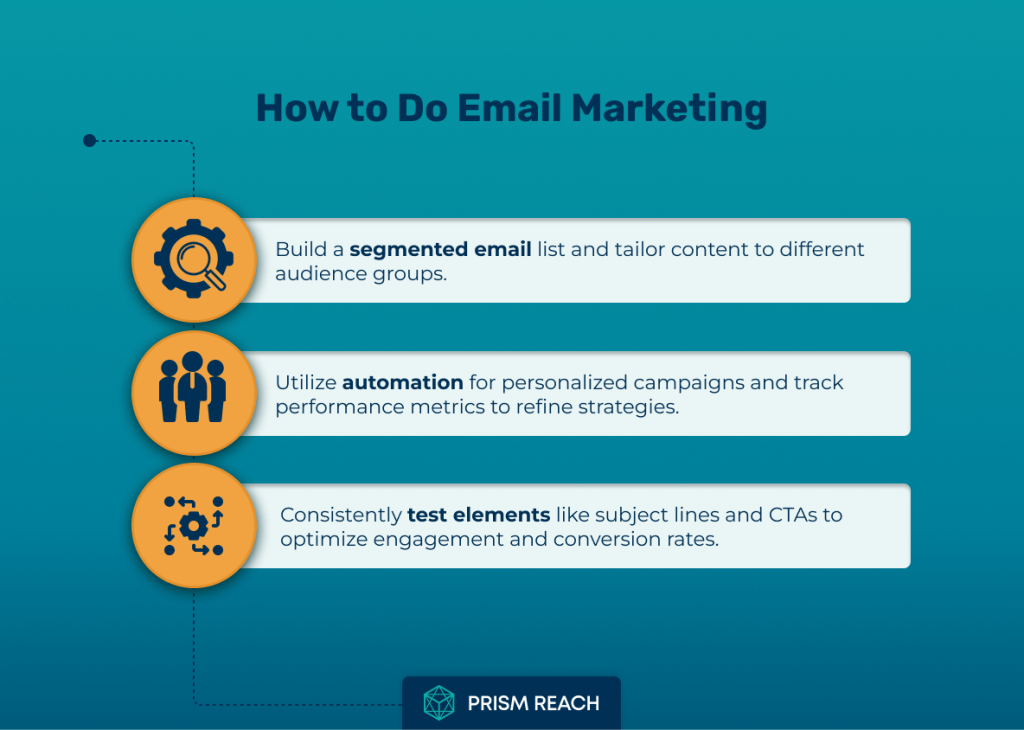
Crafting an Effective Email Marketing Strategy: A Step-by-Step Guide
1. Building an Email List from Scratch
Building an email list from scratch requires a multi-pronged approach. Start by offering a compelling lead magnet, such as an eBook, webinar, or discount code, in exchange for an email address. This incentive should provide real value to your target audience and be closely aligned with your products or services. Promote this offer across your website, social media channels, and offline events to maximize visibility and reach.
Additionally, consider implementing exit-intent popups and hello bars on your website to capture visitors’ attention before they leave your site. These tactics can be highly effective in converting casual browsers into subscribers, but it’s important to strike a balance and avoid being overly intrusive.
Consistently creating valuable content, such as blog posts, videos, or podcasts, and encouraging subscribers to share your emails with their networks can also help grow your list organically. Leverage social sharing buttons and referral programs to incentivize your existing subscribers to spread the word about your brand.
Practical Example:
Consider a SaaS company offering a free eBook on “Maximizing Productivity with AI Tools.” By promoting this eBook across their blog, social media, and during webinars, they can attract a targeted audience interested in AI and productivity tools. Implementing an exit-intent popup offering the eBook can capture additional leads from visitors about to leave the site.

2. Best Practices for Email Segmentation
Effective email segmentation is crucial for delivering personalized and relevant content to your subscribers, ultimately leading to higher engagement and conversion rates. Start by segmenting your list based on basic demographic data like age, location, and gender. This information can often be collected during the sign-up process or through integrations with your customer relationship management (CRM) system.
Next, dive deeper into behavioral data, such as purchase history, website activity, and engagement levels with your previous emails. This data can provide valuable insights into your subscribers’ interests and preferences, allowing you to tailor your messaging accordingly.
Hidden Gem: Leverage AI for Predictive Segmentation
AI-powered predictive segmentation goes beyond traditional demographic and behavioral data by analyzing patterns and predicting future behaviors. For example, Prism Reach uses sophisticated algorithms to cluster subscribers into detailed segments based on their engagement history, location, and predicted interests. This allows marketers to deliver highly personalized content that anticipates the needs and preferences of each subscriber, resulting in higher open and conversion rates.
Practical Steps:
- Continuously monitor and refine segments based on ongoing data analysis.
- Collect comprehensive data during sign-up and through user interactions.
- Use AI tools like Prism Reach to analyze and segment your audience.
- Create targeted campaigns tailored to each segment’s specific needs and behaviors.
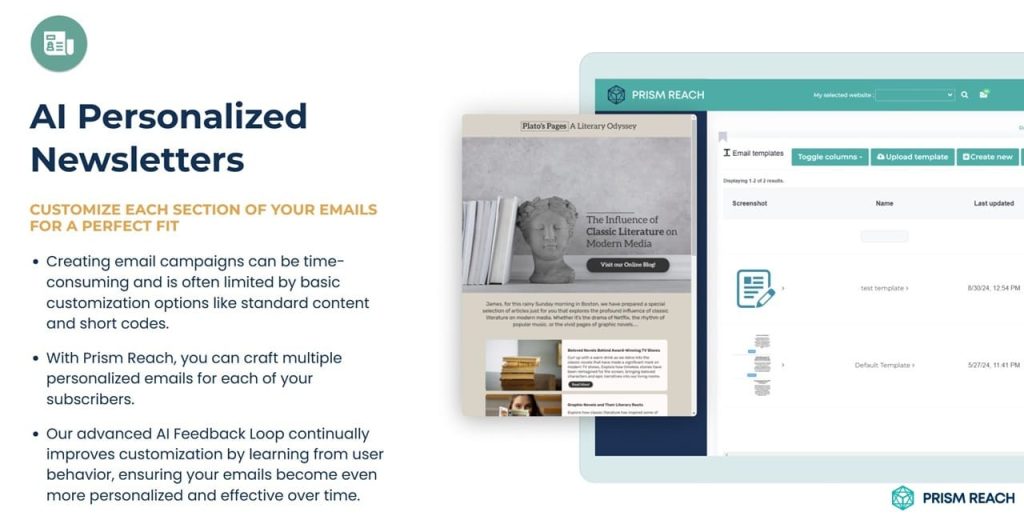
3. Creating Engaging Email Content
Creating engaging email content that drives conversions starts with understanding your audience’s pain points, interests, and preferences. Conduct market research, analyze customer data, and gather feedback from your existing subscribers to gain insights into the topics and formats that resonate most with your target audience.
Craft compelling subject lines that pique curiosity and entice recipients to open your emails. One effective strategy is the “Cliffhanger” technique—ending your subject lines with an ellipsis (…) to create suspense and encourage opens. This simple yet effective strategy can significantly increase your open rates.
Incorporate AI-generated images based on text descriptions to create unique, eye-catching visuals for your emails. This can help your emails stand out in crowded inboxes and capture your audience’s attention.
Consider implementing email treasure hunts by creating interactive treasure hunts within your emails where subscribers search for hidden discounts or offers. This gamification technique can significantly increase engagement and click-through rates.
Most importantly, ensure each email has a clear and compelling call-to-action (CTA) that guides subscribers toward the desired conversion, whether that’s making a purchase, signing up for a service, or downloading a resource.
Hidden Gem: Implement Email Treasure Hunts
Email treasure hunts add an element of fun and interactivity to your campaigns. By embedding clues or hidden codes within your email content, you encourage subscribers to actively engage with your emails. For instance, a retailer might hide a discount code in an image or within the text, rewarding the first few subscribers who discover and use the code with exclusive discounts.
Step-by-Step Implementation:
- Define the Objective: Determine what you aim to achieve—be it increased engagement, higher click-through rates, or boosting sales.
- Create Clues: Design clues that are subtle yet discoverable. These could be hidden within images, links, or text.
- Design the Email: Ensure the email layout accommodates the interactive elements without overwhelming the reader.
- Promote the Treasure Hunt: Announce the treasure hunt across your channels to maximize participation.
- Reward Participants: Offer meaningful rewards to incentivize participation, such as discounts, freebies, or exclusive access.
- Analyze the Results: Use tools like Prism Reach to track engagement and measure the success of the treasure hunt.
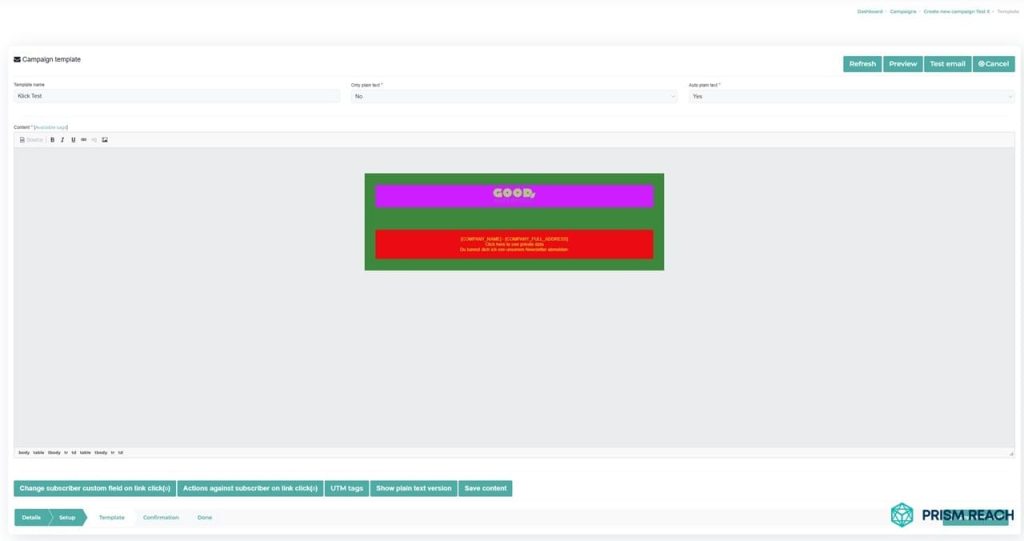
4. Leveraging Automation in Email Marketing
Automation is a game-changer in email marketing, allowing you to streamline processes and deliver personalized experiences at scale. Utilize AI-powered features like “Smart Sending” to analyze each subscriber’s email engagement behavior and send emails at the optimal time for maximum open rates. This ensures your messages are delivered when your audience is most likely to engage.
Leverage automation to set up welcome series for new subscribers, nurturing them through the customer journey and introducing them to your brand and offerings. Automated nurture campaigns can also be triggered by specific subscriber behaviors, such as abandoned cart reminders or product recommendations based on past purchases.
Additionally, automation can help optimize send times and subject lines based on individual subscriber data, ensuring your messages are delivered at the most opportune moments and with the highest likelihood of engagement.
Hidden Gem: Utilize Smart Sending with AI
Smart Sending leverages AI to determine the best times to send emails to each individual subscriber based on their past behavior. Prism Reach analyzes data points such as open times, click patterns, and engagement history to predict when a subscriber is most likely to interact with an email. This personalized sending schedule can significantly enhance open and click-through rates.
Practical Automation Examples:
- Welcome Series: Automatically send a series of onboarding emails to new subscribers, introducing them to your brand, products, and value propositions.
- Abandoned Cart Reminders: Trigger emails to remind customers of items left in their cart, encouraging them to complete their purchase.
- Post-Purchase Follow-Ups: Send thank-you emails, request feedback, or recommend related products after a purchase is made.
5. Optimizing Emails for Mobile Devices
With the majority of emails being opened on mobile devices, optimizing for mobile is no longer an option – it’s a necessity. Implement responsive email design that automatically adjusts the layout and formatting to ensure a seamless experience across various screen sizes and devices.
Keep your subject lines concise and compelling, as they often serve as the first impression on mobile. Aim for around 30-50 characters to ensure they display properly on smaller screens.
Within the email, prioritize a single-column layout that is easy to read and navigate on mobile devices. Use larger font sizes (at least 14pt) and ensure your CTAs are easily clickable on smaller screens, with ample spacing around them.
Minimize the use of complex tables and nested layouts, as these can often render poorly on mobile devices. Instead, opt for a clean, streamlined design that loads quickly and avoids excessive scrolling or zooming.
Hidden Gem: Incorporate QR Codes as CTAs
QR codes can be a highly effective call-to-action (CTA) in your emails, bridging the gap between digital and physical experiences. By embedding QR codes, you can direct subscribers to specific landing pages, promotional offers, or interactive content with a simple scan using their mobile devices.
How to Use QR Codes Effectively:
- Define the Purpose: Determine what action you want subscribers to take, such as visiting a product page or accessing a special discount.
- Generate the QR Code: Use a reliable QR code generator to create a code that links to your desired destination.
- Design Integration: Incorporate the QR code seamlessly into your email design, ensuring it is visible and easy to scan.
- Provide Instructions: Briefly explain what the QR code does to encourage engagement.
- Track Performance: Use tracking parameters to monitor how many subscribers are scanning the QR codes and engaging with the linked content.
6. Tracking Key Metrics for Success
To gauge the effectiveness of your email marketing efforts and identify areas for improvement, it’s essential to track and analyze key metrics. Open rates and click-through rates (CTRs) provide insights into the engagement levels of your subscribers and can help you understand which subject lines, content, and offers are resonating most effectively.
Conversion rates, whether for purchases, sign-ups, or other desired actions, help you understand the direct impact of your campaigns on your bottom line. Tracking revenue generated from email campaigns can further quantify the return on investment (ROI) of your efforts.
Bounce rates and unsubscribe rates can indicate issues with your list quality or content relevance. High bounce rates may suggest the need for list cleaning or improved email validation processes, while high unsubscribe rates could signal the need to reevaluate your content strategy or email frequency.
Additionally, tracking metrics like list growth rate, email sharing and forwarding rates, and website traffic from email campaigns can provide valuable insights into the overall health and effectiveness of your email marketing program.
Consider using advanced tools like Prism Reach to monitor these metrics in real-time. Prism Reach offers a comprehensive dashboard that displays audience engagement metrics, such as open rates, click-through rates, and subscription growth over time, helping you make informed decisions.
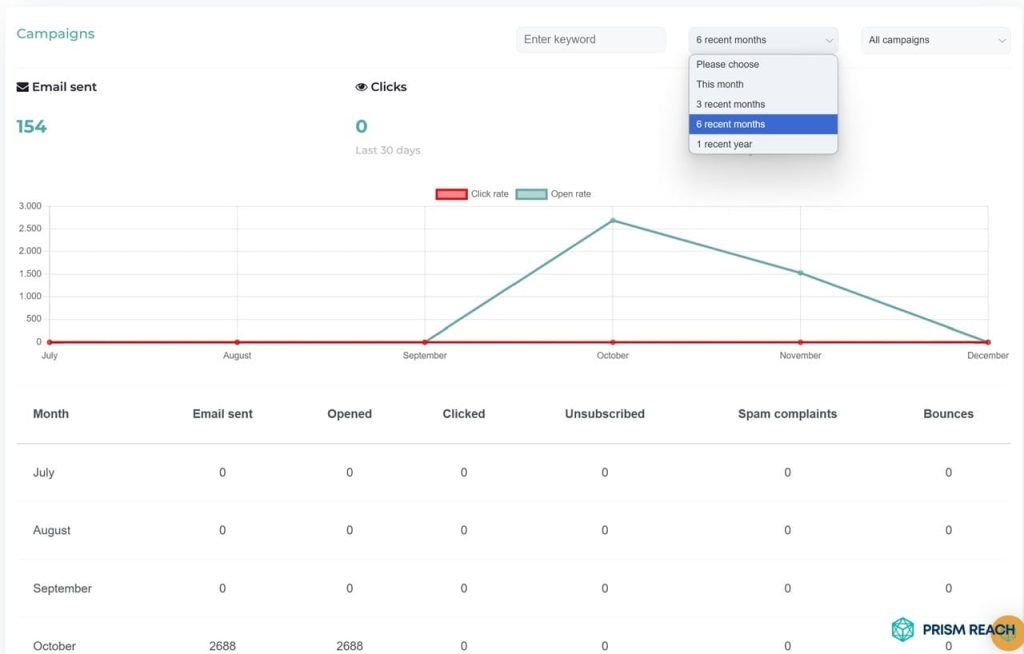
7. Ensuring Compliance with Email Marketing Regulations
Compliance with email marketing regulations, such as the CAN-SPAM Act in the United States and the General Data Protection Regulation (GDPR) in the European Union, is crucial to avoid legal penalties and maintain trust with your subscribers.
Always obtain explicit consent from subscribers before adding them to your list, and provide clear instructions on how to unsubscribe or update preferences. Include your physical mailing address and an honest subject line in every email to comply with transparency requirements.
Regularly clean your list by removing inactive or invalid email addresses to maintain high deliverability rates and avoid being flagged as a spammer. Implement processes for handling unsubscribe requests promptly and efficiently.
Additionally, be transparent about how you collect and use subscriber data, and ensure that your privacy policies and data handling practices are in line with relevant regulations.
Detailed Regulations
- CAN-SPAM Act: Requires businesses to include a physical address, provide a clear way to unsubscribe, and prohibits misleading subject lines.
- GDPR: Mandates explicit consent from EU subscribers, data protection measures, and the right to access and delete personal data.
- CASL: Canadian Anti-Spam Legislation, which requires consent, clear identification of the sender, and an easy unsubscribe mechanism.
Best Practices for Compliance:
- Obtain explicit consent through opt-in forms.
- Include a clear and easy-to-use unsubscribe option in every email.
- Provide your physical mailing address in the email footer.
- Use accurate “From” names and email addresses.
- Avoid misleading subject lines.
- Regularly update and clean your email list.
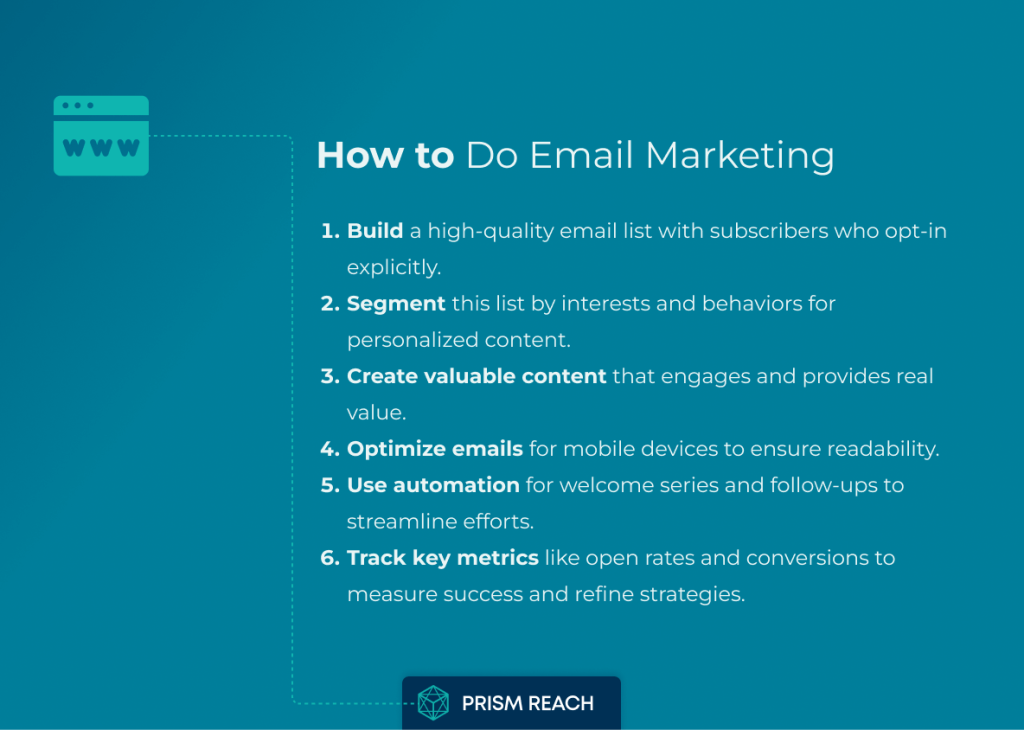
FAQ
Conclusion
Email marketing is a powerful tool that can drive significant results for your business when executed effectively. By following best practices, leveraging automation, and continuously optimizing your campaigns based on data and subscriber feedback, you can create engaging and personalized experiences that resonate with your audience and foster long-lasting relationships.
If you’re looking for a cutting-edge solution to streamline your email marketing efforts, consider exploring Prism Reach, our AI-powered platform designed to deliver hyper-personalized newsletters that captivate and convert. With advanced AI technology, Prism Reach creates unique email experiences tailored to individual subscriber interests, leading to higher engagement and increased revenue for your business.
By leveraging Prism Reach’s powerful personalization capabilities, you can take your email marketing strategy to new heights and stand out in a crowded inbox.
Potential Benefits of Prism Reach
- Increased Engagement: Through AI-powered personalization, Prism Reach can boost your engagement rates by up to 40%, ensuring your content resonates with each subscriber. By analyzing individual subscriber behavior and preferences, Prism Reach delivers highly relevant and tailored content that captures attention and encourages interaction. This deep level of personalization makes each newsletter feel uniquely crafted for the reader, fostering stronger connections and sustained interest.
- Higher Revenue: Tailored advertising and efficient content targeting lead to higher monetization rates for your published newsletters. Prism Reach’s advanced AI algorithms match advertisements and sponsored content precisely with subscriber interests, enhancing the effectiveness of your ad placements. This targeted approach not only increases click-through rates but also maximizes the value of each advertising dollar, resulting in greater overall revenue from your email marketing campaigns.
- Improved Productivity: Automation and AI-driven insights significantly reduce the time required to create and manage campaigns, allowing you to focus on strategy and creativity. Prism Reach streamlines the entire email marketing workflow by automating tasks such as content selection, personalization, and performance analysis. Additionally, the platform provides actionable insights and predictive analytics, enabling your team to make informed decisions quickly and efficiently. This enhanced productivity allows you to allocate more resources to developing innovative marketing strategies and creative content, ultimately driving better results.
By leveraging these key benefits, Prism Reach not only enhances the effectiveness of your email marketing efforts but also empowers your team to achieve greater success with less effort. Whether you’re aiming to deepen subscriber engagement, increase revenue, or streamline your marketing operations, Prism Reach offers the tools and technologies necessary to elevate your email campaigns to the next level.
Sources
- Business.com: Guide to Email Marketing
- SendGrid: Email Marketing Trends 2024
- MailerLite: Email Marketing Trends
- SpikeNow: Email Marketing Trends
- Adobe Business: Guide to Email Marketing